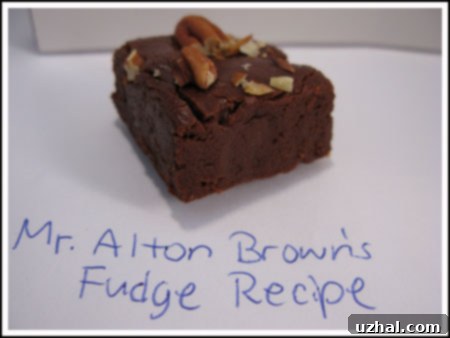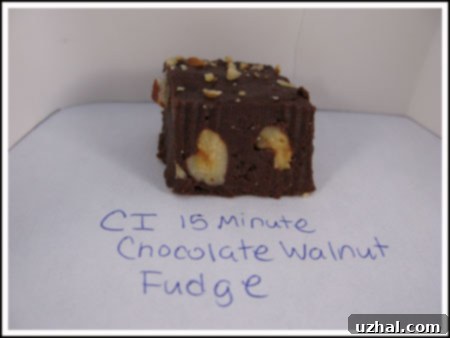The Ultimate Fudge Showdown: Comparing Three Classic Homemade Fudge Recipes
There’s something uniquely comforting and utterly decadent about a perfectly crafted piece of fudge. Its rich, melt-in-your-mouth texture and deep chocolate flavor make it an irresistible treat, especially around holidays or simply for a sweet indulgence. However, the world of fudge recipes is vast and varied, often leading to a dilemma for the home baker: which recipe truly delivers? To answer this perennial question, I embarked on a delicious mission: a back-to-back tasting comparison of three distinct and highly-regarded fudge recipes. My goal was to scrutinize each contender for its ease of preparation, texture, and, most importantly, its overall flavor profile. The contenders for this sweet showdown were the innovative Cook’s Illustrated 15 Minute Fudge (which I affectionately call “Baking Soda Fudge”), the scientifically-backed Alton Brown fudge recipe, and the timeless, budget-friendly Hershey’s Classic Rich Cocoa Fudge. Join me as I delve into the nuances of each, helping you discover which recipe might be your next go-to for homemade fudge perfection.
Contender 1: Cook’s Illustrated 15-Minute Fudge (The Baking Soda Trick)

First up in our sweet challenge was the Cook’s Illustrated 15-Minute Fudge, a recipe that piqued my interest with its rather unconventional secret ingredient: baking soda. Cook’s Illustrated, renowned for their meticulous testing and innovative kitchen hacks, promises an easy, quick fudge by building upon the popular “Foolproof Fudge” method. This traditional approach typically involves combining chocolate with condensed milk, a simple technique known for producing a soft, albeit often too soft, fudge. The genius of Cook’s Illustrated lies in their addition of baking soda. The idea is that the baking soda, when reacting with the acidic components in the chocolate and condensed milk (lactic acid), helps to create small air pockets and slightly alter the protein structure, leading to a firmer, drier texture that more closely resembles traditional fudge.
True to their word, the baking soda definitely worked its magic. The resulting fudge was noticeably stiffer and had a drier crumb compared to a straight condensed milk fudge. It tasted good, with a pleasant sweetness and chocolate flavor, but it didn’t quite capture my heart. While the texture was improved, moving away from the overly sticky, almost caramel-like consistency of its “foolproof” predecessor, it still necessitated refrigeration to maintain its desired firmness. More importantly, it lacked that elusive, ethereal quality – the melt-in-your-mouth richness that distinguishes truly exceptional fudge. It was a good, quick option for those moments when you need fudge in a hurry and don’t mind a slightly chewier, less velvety bite, but it didn’t quite reach the pinnacle of fudge perfection I was hoping for. It serves as an excellent gateway recipe for beginners or those seeking a very fast dessert, but for the discerning fudge connoisseur, the journey continues.
Contender 2: Alton Brown’s Classic Chocolate Fudge

Next on the tasting agenda was the Alton Brown Fudge recipe. Alton Brown, known for his scientific approach to cooking, often delivers recipes that are not just delicious but also incredibly reliable once you understand the underlying principles. There were some minor discrepancies between the version he demonstrated on his show and the recipe posted on the Food Network website. After a quick search and finding that many home cooks had successfully used the website’s version, I opted for that one to ensure consistency with widely available instructions. This recipe distinguishes itself by using no condensed milk or marshmallow crème, relying instead on traditional ingredients like sugar, butter, milk, and chocolate.
My first attempt, however, was a learning experience. The mixture got too hot in my thin stainless steel saucepan, leading to a grainy, sugar-crystalized fudge – a common pitfall in candy making. Undeterred, I tried again, this time employing a heavy-duty nonstick saucepan which offered more even heat distribution and better temperature control. The second attempt was nothing short of perfect. The texture was smooth, creamy, and possessed that desirable melt-in-your-mouth quality that was missing from the first contender. I also made a small but impactful addition: about ¼ teaspoon of salt. This simple tweak brilliantly enhanced the chocolate flavor, cutting through the sweetness and adding a layer of complexity that elevated the fudge significantly. If you’re searching for a robust homemade fudge recipe that eschews shortcuts and delivers on classic flavor and texture, this Alton Brown recipe is definitely one to experiment with. Its reliance on precise temperature control makes it slightly more demanding, but the reward is a truly superior fudge that feels wonderfully authentic and deeply satisfying.
Contender 3: Hershey’s Classic Rich Cocoa Fudge (An Old-Fashioned Delight)

For the third and final fudge of the day, I turned to a truly old-fashioned classic: the Hershey’s Classic Rich Cocoa Fudge recipe. This recipe, relying solely on cocoa powder rather than solid chocolate, presents a different flavor profile. Typically, cocoa powder is less rich and intense than baking chocolate, and without the addition of cream or half-and-half (as many recipes use), my initial expectations for this fudge weren’t particularly high. I anticipated a more subtle chocolate flavor and perhaps a slightly less luxurious texture. However, I was pleasantly surprised – this fudge far exceeded my modest expectations.
This Hershey’s fudge was, unequivocally, “the real deal.” It delivered a delightful light texture that melted beautifully, combined with a surprisingly rich and profound chocolate flavor. The simplicity of cocoa powder allowed the pure essence of chocolate to shine through, unburdened by the complexities of different chocolate types. While I didn’t love it quite as much as the Alton Brown fudge (which had a slight edge in its creamy depth), it was remarkably close and possessed a charm of its own. Given how much more economical it is to make this cocoa-based fudge compared to recipes that call for substantial amounts of high-quality baking chocolate or condensed milk, it truly is a recipe worth mastering. It offers an authentic, old-school fudge experience without breaking the bank, making it perfect for large batches or when you simply want a delicious, no-fuss chocolate treat. Its robust flavor and satisfying texture make it a strong contender, proving that sometimes, the simplest ingredients yield the most satisfying results.
Comparative Analysis: Finding Your Fudge Favorite
After sampling all three contenders, a clear picture emerges regarding their unique attributes and ideal uses. The Cook’s Illustrated 15-Minute Fudge excels in speed and simplicity. It’s the perfect solution for sudden fudge cravings or when you need a quick dessert for a gathering. Its baking soda trick genuinely improves the texture of condensed milk fudge, making it firmer, but it still doesn’t achieve the velvety melt of traditional fudge and requires refrigeration. For those new to fudge-making or seeking an almost instant gratification, this is a solid, albeit not perfect, choice.
The Alton Brown Fudge stands out for its superior texture and rich, deep chocolate flavor. It truly embodies the classic fudge experience, smooth and exquisitely creamy, dissolving beautifully on the tongue. However, this perfection comes with a prerequisite: precision. Temperature control is crucial, and a good quality heavy-bottomed saucepan is essential. It’s a recipe for those who appreciate the craft of candy making and are willing to invest a little more time and attention for an exceptional result. The absence of condensed milk or marshmallow crème makes it feel more “from scratch” and sophisticated.
Finally, the Hershey’s Classic Rich Cocoa Fudge offers an incredible balance of flavor, texture, and economy. Its light, yet rich, chocolatey profile is surprisingly satisfying, especially considering its humble ingredients. This recipe is a fantastic option for everyday indulgence, for making large quantities without excessive cost, or for those who prefer the distinct taste of cocoa powder over solid chocolate. It’s a testament to timeless recipes and proves that deliciousness doesn’t always require expensive ingredients.
The Verdict and Future Fudge Adventures
While all three recipes delivered enjoyable fudge, my personal preference leaned towards Alton Brown’s recipe for its unparalleled texture and classic flavor. It truly felt like the quintessential homemade fudge. The Hershey’s recipe was a very close second, winning points for its surprising richness and incredible value. The Cook’s Illustrated recipe, while ingenious for its speed, ultimately fell short of the ideal fudge texture for my palate.
This fudge journey has been incredibly enlightening, highlighting the diverse paths one can take to achieve this beloved confection. Each recipe offers a different experience, catering to various skill levels, time constraints, and taste preferences. But the adventure doesn’t end here! Several people swear by the marshmallow crème jar recipe, affectionately known as “Fantasy Fudge.” Its legendary status for ease and consistency makes it an obvious next target for my ongoing quest to find the ultimate fudge. Stay tuned for more sweet experiments as I continue to explore the wonderful world of homemade fudge!
